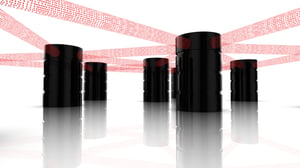 When we talk about Software Defined Storage (SDS), we are referring to virtual storage. The first thing you should know about SDS is that it’s highly likely you have been working with virtual storage for a long time in your data center even if you are an SMB and only have one server. You’ve done so by configuring a RAID on your server. Perhaps your server had five physical drives. Chances are you took two of them and made a RAID 1 mirror which you then designated as your OS volume. Then you took the remaining three disks and made a RAID 5 strip with parity that you then utilized as your data volume for a SQL-based application. In the process, you took a container of five physical disks and you created a virtual configuration that ideally suited your environment. That is what virtualization does. SDS allows for “user-defined storage” in the same way.
When we talk about Software Defined Storage (SDS), we are referring to virtual storage. The first thing you should know about SDS is that it’s highly likely you have been working with virtual storage for a long time in your data center even if you are an SMB and only have one server. You’ve done so by configuring a RAID on your server. Perhaps your server had five physical drives. Chances are you took two of them and made a RAID 1 mirror which you then designated as your OS volume. Then you took the remaining three disks and made a RAID 5 strip with parity that you then utilized as your data volume for a SQL-based application. In the process, you took a container of five physical disks and you created a virtual configuration that ideally suited your environment. That is what virtualization does. SDS allows for “user-defined storage” in the same way.
Compute virtualization is what opened Pandora’s Box in the data center and revealed to us the benefits of a software driven model over a traditional hardware one. Ironically, the typical virtual server farm that delivers the advantages of cost savings and agility of a software defined solution is saddled with a traditional storage device such as a SAN that is completely hardware driven.
DISADVANTAGES OF THE HARDWARE APPROACH
A SAN is a very robust device. It is designed to withstand a sizable degree of hardware failure by integrating great redundancy into the hardware design. A SAN can consist of multiple shelves of drives, each shelf composed of one or more RAIDs with designated hot spares. Shelves can then be mirrored together to form a RAID 50. To complete the redundancy, the SAN requires multiple controllers which require multiple iSCSI switches. It has a custom proprietary operating system that has to be updated and patched regularly. It is no wonder then that storage array vendors spend millions in development costs creating these monolithic robust structures, which is why SANs are so expensive. In addition, vendors have to spend much of their time designing and testing proprietary components and conducting interoperability testing.
It’s not just the expense that drags down the appeal of hardware based storage devices. A SAN may consist of a great number of disk drives, but that doesn’t translate into scalability. There is a limit to the number of drives a controller can manage and a limit to the number of controllers that can be interconnected. SANs are designed for multi-tenant environments as there is typically a very limited number of administrators, many times only one.
This serves as an obstacle for multiple workloads and selfprovisioning deployments. In addition, you’re locked in to a particular vendor, increasing opportunity costs and forcing future complicated data migrations. Finally, an enterprise may have multiple storage arrays from multiple vendors, each requiring a separate unique management console that eliminates any chance of cohesion.
ADVANTAGES OF THE SOFTWARE APPROACH
Software Defined Storage takes an entirely different approach. SDS is hardware agnostic, period. It is fully compatible with x86 architecture and works with nearly any storage platform, integrated or DAS. Thanks to SDS technology, servers today are being designed with small sized flash based disks that can handle petabytes of storage on their own. This means that the files for your virtual machines and applications can be stored on the disks residing on their host servers. The implications of this are enormously beneficial in that not only is the control plane separated from the hardware, but it puts the server and its corresponding storage on the same control plane. This greatly simplifies management for not just storage but for the entire ecosystem. Virtual machines can now communicate with their assigned file systems through the system bus rather than the iSCSI network, just as the virtual machines communicate with one another without accessing the network. This greatly increases speed and performance. What you end up with is a hyper-visor conglomerate in which all facets of the virtual farm coexist together.
Essentially, SDS is a software application that resides above the server infrastructure. SDS vendors don’t have to bother with proprietary hardware designs and R&D costs. Because SDS utilizes the existing infrastructure, IT managers can fully utilize their existing structures or even reuse older equipment. It also gives them the flexibility to transition to newer technologies. SDS vendors don’t have to worry about a customized operating system. SDS software simply uses the operating system you presently have. All you have to do is simply install the application orchestrator and start implementing advanced data services such as snapshotting, thin provisioning and multisite replication.
The idea of trusting x86 architecture for your data storage may seem somewhat backwards in thinking. It doesn’t sound as reliable as a SAN and from a hardware perspective that is definitely true. SDS is about running a dependable advanced software orchestrator over unreliable hardware. In the same fashion that vMotion will automatically migrate virtual machines to another host should environmental conditions become threatened or compromised, SDS will fluidly adjust to conditions as well. SDS was built from the ground up with the complete assumption that underlying hardware will fail, which is why it is designed to scale out to thousands of nodes and seemingly unlimited drives. This creates a redundant storage web to save, backup, and manage your data. This scalability not only prevents a single point of failure from occurring, but complete system reboots are now a thing of the past. Storage drives from one node can be brought down for repair or upgrade without bringing down the entire storage system.
SDS was created with multi-tenancy in mind which allows for multiple workloads, allotting for user provisioned storage. This makes SDS ideal for remote branch offices that require their own storage. Even more appealing is the idea of a turn-key hypervisor solution in which a vendor can deliver a simple hyper virtual conglomerate that can be powered up and have virtual machines, their required storage and corresponding applications configured and deployed within a single day.
EMBRACE THE STORAGE DISRUPTION
SDS is a disruptive technology that is changing the storage landscape of the data center and sending storage vendors scrambling to adjust their product models. Perhaps the most appealing aspect of SDS is that because it is hardware agnostic and works with multiple hypervisors, its inherit agility and adaptability will prevent disruptiveness of changing hardware technology. While SDS may be disruptive now, it paves the way for the data center and uninterrupted environment of the future, which may be the greatest benefit of all.
About WEI
WEI is an innovative, full service, customer-centric IT solutions provider.
Why WEI? We go further.
At WEI, we’re passionate about solving your technology problems and helping you drive your desired business outcomes. We believe in challenging the status quo and thinking differently. There are a lot of companies that can take today’s technology and create a great IT solution for you. But we do more. We go further. And we have the customer, vendor and industry awards to prove it. WEI is a premier technology partner, who always puts our customers first while providing the most innovative solutions for over 30 years.


